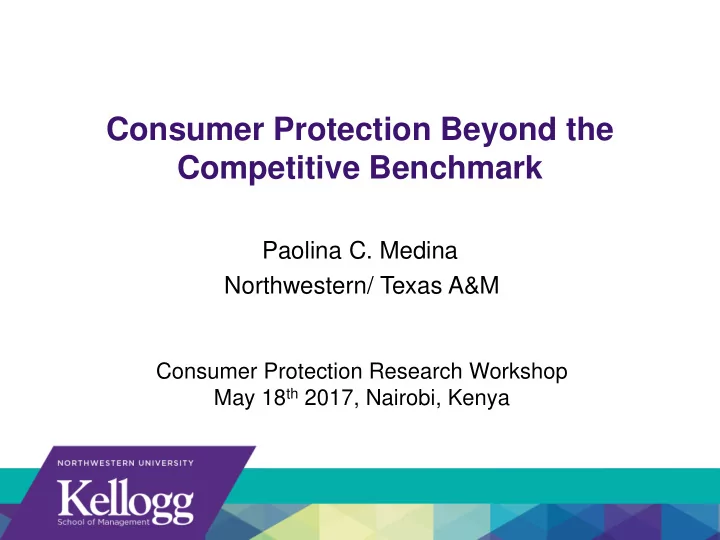

Consumer Protection Beyond the Competitive Benchmark Paolina C. Medina Northwestern/ Texas A&M Consumer Protection Research Workshop May 18 th 2017, Nairobi, Kenya DEPARTMENT NAME
How to ensure that consumers receive a “fair” treatment in financial markets? The competitive benchmark: Fixing standard market failures, and LET markets work for consumers. Beyond the competitive benchmark: Fixing behavioral market failures, and HELP markets work for consumers. 2
Standard interventions to promote competition may not be enough The case of contingent fees 1. Disclosure 2. Innovation 3
Disclosure of contingent fees Competitive benchmark: • Consumers become aware of product fees. • Consumers shop for the best deal, inclusive of fees. • Firms have incentives to lower fees. 4
Disclosure of contingent fees Beyond the competitive benchmark: • Consumers UNDERESTIMATE the likelihood of incurring the fees (extreme with zero probability). • Even if they become away of product fees, consumers shop for the best deal, without considering fees. • Firms have no incentive to lower fees. 5
Innovation: easier to use products The case of credit cards • Low upfront fees – zero percent interest if paid in full, frequent flier miles, cash back. • High late payment fees, and high interest. Competitive benchmark • If simplicity is valued, someone will profitable offer a simplified product. 6
Innovation: easier to use products Beyond the competitive benchmark 1. Some consumers always pay on time in full, and enjoy all benefits. 2. Some consumers think they will pay on time and enjoy benefits, but end up paying interests. 3. Some consumers consciously pay interest and late payment fees. Who will value a simplified credit card, that charges no late fees, has lower interest rate, but gives no cash back, frequent flier miles, etc? 7
8
Non-standard interventions may help 1. Price caps on shrouded attributes 2. Nudges 3. Extra – Personal Financial Management 9
Price caps on shrouded attributes Competitive benchmark: Ration supply of credit, or increase prices in other margins. Beyond competitive benchmark: Consumers pay more attention (are more responsive) to interest rates than to credit card fees. Agarwal et.al. 2015 Cap on credit card fees reduced cost of borrowing by 1.7% of daily balances. More than 5% decrease for users with low credit score. No evidence of an offsetting increase in interest charges or a reduction in volume of credit. 10
Price caps on shrouded attributes Other margins? – research gap. Exploitative innovation (Heiduhes, et.al. 2015) • Are there new fees being created? Are there additional complexities being added to credit cards? – Inactivity fees, and new definitions of international transactions (Frank 2009). 11
Nudges • Nudge: gentle push to take a certain action, without significant changes in economic incentives. • Examples: – Reminders to save – Commitment devices – Defaults and automatic enrollment. • Lots of evidence for effectiveness to induce specific behavior. • Less evidence on welfare, and little guidance on what behavior to induce. 12
Nudges Welfare and efficiency – research gap. – Alcott and Kessler (2015) on peer comparisons to reduce electricity consumptions. • Elicit consumers willingness to pay for nudge, and do welfare evaluation. • Some consumers do not want to receive the nudge. – Medina (2017) on reminders for credit card timely payment. • Richer set of outcomes: transactions on credit cards and checking accounts. • Some consumers avoid credit card late payment fees, but incur overdraft. 13
Nudges Does one size fit all? - research gap. • Don’t need to induce same behavior for all consumers. – Targeting for x2 benefits of Alcott and Kessler 2015, and Medina 2017. • Personalized messages for higher effectiveness to induce specific behavior (Juntos). 14
Personal Financial Management 15
Recommend
More recommend